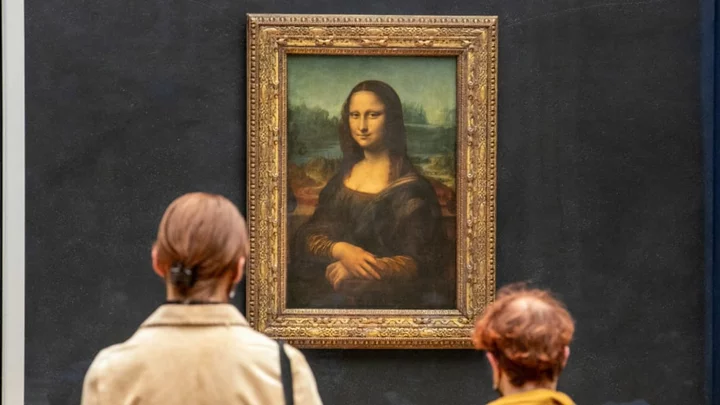The Mona Lisa’s tricky smile and timeless allure have inspired academic study and artistic emulation for more than five centuries—but the story of Leonardo da Vinci’s perplexing portrait is even richer than it looks.
1. Mona Lisa isn’t the subject’s name.
The painting’s subject is commonly thought to be Lisa Gherardini, whose wealthy—and presumably adoring—husband Francesco del Giocondo commissioned the work in Florence, Italy, around 1503. This explains the less prevalent title for the painting, La Gioconda, or La Joconde in French. The name Mona Lisa (or Monna Lisa, as the Italians prefer) roughly translates to “My Lady Lisa.”
2. Leonardo da Vinci didn’t finish the painting.
When Leonardo died in 1519, it’s thought that the unfinished Mona Lisa was bequeathed to his assistant. Some have speculated the artist might have left the painting undone because of some type of paralysis that impeded his dexterity.
3. Napoleon loved the Mona Lisa.
The French emperor once had Mona Lisa hanging in his bedroom in the Tuileries Palace for about four years, beginning in 1800. It’s said his fascination with the painting inspired his affection for a pretty Italian woman named Teresa Guadagni, who was actually a descendant of Lisa Gherardini.
4. Mona Lisa is smaller than you might think.
Mona Lisa’s influence on culture is massive, but the oil-on-wood panel painting measures just 30 inches by 21 inches and weighs 18 pounds.
5. Her eyebrows are a matter of debate.
Some claim the subject’s lack of eyebrows is representative of high-class fashion of the time. Others insist her AWOL eyebrows are proof that Mona Lisa is an unfinished masterpiece. But in 2007, ultra-detailed digital scans of the painting revealed Leonardo had once painted on eyebrows and bolder eyelashes. Both had simply faded over time or had fallen victim to years of restoration work.
6. The Mona Lisa has broken a lot of hearts.
The portrait was first put on public display in the Louvre in 1815, inspiring admiration, as a string of “suitors bearing flowers, poems, and impassioned notes climbed the grand staircase of the Louvre to gaze into her ‘limpid and burning eyes,’” journalist Dianne Hales writes in Mona Lisa: A Life Discovered.
According to author R. A. Scotti in Vanished Smile: The Mysterious Theft of Mona Lisa, the painting “often made men do strange things. There were more than one million artworks in the Louvre collection; she alone received her own mail. Mona Lisa received many love letters, and for a time they were so ardent that she was placed under police protection.” The painting has its own mailbox at the Louvre because of all the love letters its subject receives. (Some men have allegedly been so enamored with the painting that they have chosen to die by suicide—one of them in front of it.)
7. The Mona Lisa is essentially priceless.
In the 1960s, the painting went on a tour where it was given an insurance valuation of $100 million (factoring in inflation, a 2014 assessment estimated it was worth $2.5 billion). But the policy was never taken out because the premiums were more than the cost of the best security.
8. The painting hangs in a climate-controlled room.
Mona Lisa is the star of the Louvre’s Grand Gallery, where it is climate-controlled to keep the painting in the ideal environment. (According to the Associated Press, the system that cools the Louvre is part of 55 miles of underground pipes that transport water cooled by renewable energy sources to keep more than 700 sites nice and frosty.) Additionally, the work is encased in bulletproof glass to prevent threat and injury.
9. The Mona Lisa has been attacked several times.
If you look closely at the subject’s left elbow, you might notice the damage done by Ugo Ungaza Villegas, a Bolivian man who chucked a rock at the portrait in 1956. A few months before, another art attacker pitched acid at the painting, which hit the lower section. These attacks inspired the bulletproof glass, which in 2009 successfully rebuffed a ceramic mug hurled by an enraged Russian woman who had been denied French citizenship. Most recently, the glass also protected the Mona Lisa when a man wearing a wig lobbed cake at the painting in 2022, screaming “think of the earth, people are destroying the earth!” as he was subdued by guards.
10. France mourned en masse when the Mona Lisa went missing.
On August 21, 1911, the Mona Lisa was stolen from the Louvre. The New York Times retroactively compared the public display of grief to that seen in the wake of Princess Diana’s death in 1997: Thousands came to the Louvre to stare in shock at the blank wall where the painting once hung, leaving behind flowers, notes, and other remembrances.
11. Pablo Picasso was a suspect in the caper.
Because he’d been caught buying stolen Louvre pieces before, Pablo Picasso was brought in for questioning. But the true thief would not be caught until 1913.
Louvre employee Vincenzo Peruggia was a proud Italian nationalist who smuggled the painting out under his smock because he felt it belonged to his and Leonardo’s homeland, not France. After hiding it for two years, Peruggia was busted trying to sell the Mona Lisa to a Florence art dealer. However, he did briefly get his wish: After the painting was recovered, it toured Italy before returning to Paris.
12. Suspicions arose that the heist wasn’t a one-man job.
Though Peruggia was the only one prosecuted for stealing the Mona Lisa, it’s unlikely he acted alone. At the time of the theft, the painting was encased in a heavy wood backing and glass case that would have weighed almost 200 pounds, making it highly unlikely Perugia could have pulled it down from the wall on his own.
Years later, a man who called himself the Marquis of the Vale of Hell confessed to American reporter Karl Decker that he was the true mastermind behind the theft of the Mona Lisa. On the condition his story be kept secret until his death, he revealed Peruggia was one of three men paid handsomely to snatch her. This way, the Marquis could sell multiple forgeries of the masterpiece to collectors for exorbitant sums. The beauty of the scam was that each buyer would believe they owned the authentic missing Mona Lisa. Whether the Marquis was telling the truth or not is still a hotly debated topic around the theft.
13. The Mona Lisa’s return inspired a fashion trend.
Hales writes in Mona Lisa: A Life Discovered that “Society women adopted the ‘La Joconde look’ [named for the painting’s French title], dusting yellow powder on their faces and necks to suggest her golden complexion and immobilizing their facial muscles to mimic her smile. In Parisian cabarets, dancers dressed as La Joconde performed a saucy can-can … Something beyond the painting’s wild popularity had changed. The Mona Lisa had left the Louvre a work of art; she returned as a public property, the first mass art icon.”
14. Mona Lisa’s smile doesn't change, but your mindset does.
That is-she-or-isn’t-she smile has long fascinated artists and historians. But in 2000, Harvard neuroscientist Dr. Margaret Livingstone applied a scientific method to why the Mona Lisa’s smile seems to shift: It’s all about where your focus is and how your brain responds.
15. Some believe the subject of the Mona Lisa is actually frowning ...
There are those who, upon conjuring up a mental image of the Mona Lisa, see the famous painting’s subject wearing an expression that’s more like a frown than a smirk. It’s an example of a shared false memory, otherwise known as the Mandela Effect. Other famous examples include a monocle-wearing Monopoly man and Jiffy Peanut Butter.
16. ... but a 2017 study revealed most people think she’s happy.
To determine whether the subject of the Mona Lisa was giving off more happiness or more sadness, scientists at the University of Freiburg showed 12 people nine photos of the painting: One was the original, while the other eight had been digitally manipulated around the mouth to show the subject as either happier or sadder. The photos were shuffled and shown to every participant 30 times; 97 percent of the time, they said the original painting appeared happy.
A version of this story ran in 2015; it has been updated for 2023.
This article was originally published on www.mentalfloss.com as 16 Things You Didn’t Know About the ‘Mona Lisa’.









